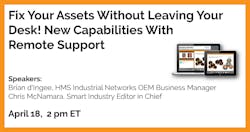Webinar Highlights: Fix Your Assets Without Leaving Your Desk! New Capabilities With Remote Support
In April we connected with HMS Networks’s Brian d’Ingee for the Spring INSIGHT webinar “Fix Your Assets Without Leaving Your Desk! New Capabilities With Remote Support.” (Click to access it on demand.)
Here find a summary of that presentation with a quick chat about the evolution of remote assets, resulting challenges in supporting them, and digital approaches that can optimize (and secure) those efforts...
Smart Industry: How is remote support of industrial assets evolving?
Brian: With the ability to retrieve data from factory-floor equipment, remote support is gradually moving toward a proactive maintenance approach, instead of just reactive. This, of course, requires continuous network connectivity from equipment on the factory OT layer to the IT layer network. IT personnel have become actively involved with the technologies used for secure remote support at the OT network layer.
Smart Industry: How are service models changing in our digital era? Who can most benefit?
Brian: The traditional reactive-maintenance model functioned on a run-to-failure mentality. This model is still common because it requires the least amount of upfront investment in service, but it can result in significant unplanned downtime and cost manufacturers millions of dollars in lost productivity. However, proactive-maintenance models have evolved focusing on monitoring equipment and determining the probability that it will fail within a certain time period. This enables equipment owners to focus service on planned downtime and limit the disruption to their business. These benefits can be realized by anyone who touches the equipment, from the machine builder (who often carries the support burden for the equipment), to the factory owner (who needs to keep their overall cost of ownership low).
Smart Industry: Does remote always mean more vulnerable in terms of cybersecurity? What mindset / strategy is critical in keeping safe while going remote?
Brian: No, when we consider security breaches, they most often come from compromises to internal assets such as a person responding to a phishing email with their network credentials. Whether local or remote, the key is to focus on a sound security process that takes into account the hardware assets and tools that need to be protected, including the users who need to be properly validated and maintained. Certain high-profile security breaches that originated from remote connections were tied to failures in the security process and not to any inherent structural weakness.
